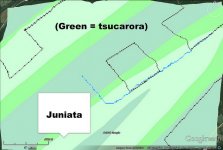T
troutbert
Well-known member
- Joined
- Nov 2, 2006
- Messages
- 10,668
Regarding this study by Bucknell. Keep in mind that they only studied the ridge-and-valley region of PA, not other regions of the state.
They did not study the Allegheny Plateau (AP) region at all. The Allegheny Plateau is about 2/3 of the state of PA. And the great majority of public forest lands in PA are in the AP.
The mileage of acid rain impacted streams on the Allegheny Plateau is many, many times larger than that found in the ridge-and-valley.
The acid precip issues on the Allegheny Plateau have been extensively studied by others, but were not part of the Bucknell study.
They did not study the Allegheny Plateau (AP) region at all. The Allegheny Plateau is about 2/3 of the state of PA. And the great majority of public forest lands in PA are in the AP.
The mileage of acid rain impacted streams on the Allegheny Plateau is many, many times larger than that found in the ridge-and-valley.
The acid precip issues on the Allegheny Plateau have been extensively studied by others, but were not part of the Bucknell study.




